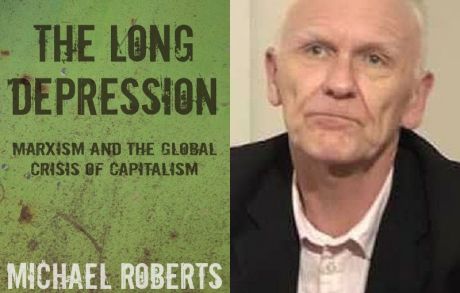Arts
You are here
The falling rate of profit and the long depression

January 10, 2017
The Long Depression: How it Happened, Why it Happened, and What Happens Next
Written by Michael Roberts
Review by Peter Hogarth
The recession that started in the United States in 2007-2008 and quickly spread around the world, continues to loom large. Governments everywhere are trying to cope with an economic landscape where high unemployment, low wages and incredible income inequality between the extremely wealthy and the rest of us is the norm. The political landscape has been characterized by notable explosions of anger at the way things are, including massive strikes and protests to kick out an austerity-driven president in South Korea to the election of Donald Trump who came to power on promises of scapegoating immigrants and bringing back manufacturing and coal jobs in America. In The Long Depression, Michael Roberts looks deeply at why the economy, despite rosy predictions and some signs of growth,
The main message of the book is that the major economies of the world are in a long depression. That means that, since 2008, economies are growing at well below their previous rate of output and below the long-term average. As well, employment and investment and profitability are lower than levels before the start of the depression.
The book spends a lot of time examining theories from mainstream economists, neoclassical and Keynesian, and their inability to identify the root cause of the 2008 economic crisis, or previous economic crises for that matter. Most of the mainstream explanations of the major economic crises have been debt inflation, bad monetary policy, credit bubbles, and a rigid gold standard. Roberts asserts that these are symptomatic of a much deeper long-term crisis in the system. To prove this he returns to Marx and looks at the depressions in 1870, 1929 and 2008.
When economists examining recessions and depression point to “lagging investment” or a “turn to financialization” or “bad debt” as reasons for the crises of the economic system, Roberts asks “but why?” And he has an answer: the underlying cause of depressions in capitalist economies lies with Marx’s law of the tendency of the rate of profit to fall.
Rate of profit
Marx’s law begins with a crucial assumption: value can only be generation by the work of people. That means that factories, equipment, software and raw materials cannot create profit unless people (living labour) use them. Capitalists raise profits paying workers less than the value of the goods and services they produce. Subtracting the cost of plant and equipment, this extra value is called surplus value. As capitalists try to compete to reduce their costs relative to price, they invest more and more money into technology and equipment (constant capital) to try and increase the productivity of their workforce (variable capital). This ratio of constant capital to variable capitals will rise over time and, thus, reduce the rate of profit.
As the rate of profit falls it reduces the total profit. When profit rates are low and returns on investment are low, and capitalists cease to invest in productive capital (the manufacture of goods and services that people use). As Roberts shows in his study of the three big modern depression periods, capitalists will turn to investing heavily in “fictitious capital” (credit, debt, speculation etc); this turn to investment in unproductive sectors can help maintain the economy and compensate for a falling rate of profit, but will eventually collapse and cause a crisis when real value expansion can no longer sustain it.
Socialism or barbarism
As capitalists and their governments search for ways to return profitability to the system through austerity and raising the level of exploitation of workers, Roberts identifies the long-term problem clearly with the system itself. Because capitalism is a system that runs based on the accumulation of profits, methods of increasing aggregate demand or tinkering with monetary policy, simply kick the can down the road. The long-term tendency of the rate of profit to fall relative to surplus value (the source of profits) can only be resolved by a slump and the devaluation of the existing capital employed, to start the process of accumulation and growth again. That would mean tremendous amounts of pain and suffering for most people and increased inequality.
However, as Roberts notes, the capitalist system can survive as long as working people pay for it through increased exploitation, lower living standards and increased inequality. Instead, Roberts’ conclusion advances an alternative vision. “Capitalism can only be replaced by a new system of social organization through conscious action of human beings, in particular by the majority of people (the working class globally). Without such conscious action, capitalism can stumble on or fall back into barbarism.” The recognition of the very foundational nature of capitalist crises and the dead-end of attempts to reform the system drive Roberts to insist on the necessity of a “planned economy owned in common and controlled by the majority” as the alternative.
Section:










